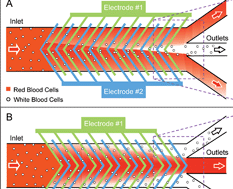Lateral-driven continuous dielectrophoretic microseparators for blood cells suspended in a highly conductive medium†‡
Abstract
This paper presents lateral-driven continuous dielectrophoretic (DEP) microseparators for separating red and white blood cells suspended in highly conductive dilute whole blood. The continuous microseparators enable the separation of blood cells based on the lateral DEP force generated by a planar interdigitated electrode array placed at an angle to the direction of flow. The simplified line charge model that we developed for the theoretical analysis was verified by comparing it with simulated and measured results. Experimental results showed that the divergent type of microseparator can continuously separate out 87.0% of the red blood cells (RBCs) and 92.1% of the white blood cells (WBCs) from dilute whole blood within 5 min simply by using a 2 MHz, 3 Vp-p AC voltage to create a gradient electric field in a medium that conducts at 17 mS cm−1. Under the same conditions, the convergent type of microseparator could separate out 93.6% of the RBCs and 76.9% of the WBCs. We have shown that our lateral-driven continuous DEP microseparator design is practical for the continuous separation of blood cells without the need to control the conductivity of the suspension medium, overcoming critical drawbacks of DEP microseparators.


 Please wait while we load your content...
Please wait while we load your content...